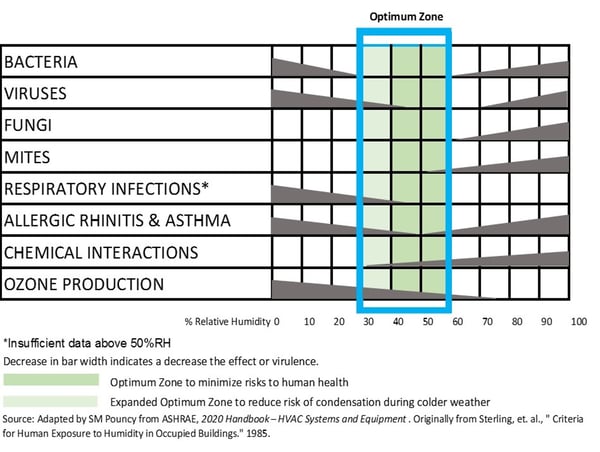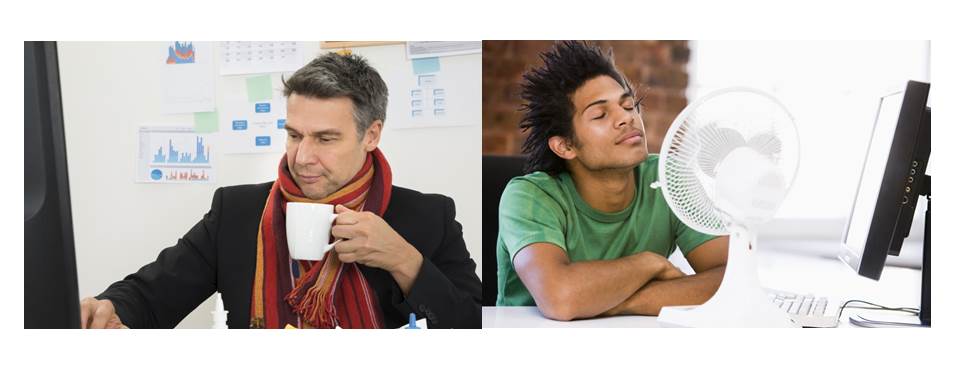In the age of COVID, we have to look at all available - and viable - options for occupant safety.
To help slow the spread of the coronavirus, ASHRAE, CDC (Centers for Disease Control and Prevention) and WHO (the World Health Organization) currently recommend running HVAC systems for a minimum of 4 hours (but preferably more) on a daily basis with 100% outside air (OA) to “flush out” the virus. I would love to be 100% on board with this recommendation all year round. But I’m not.
While the virus might be “flushed out” during that time, it doesn’t mean the germs are flushed off surfaces like doorknobs, railings, tables and faucets. And the results only last as long as 100% OA continues. Otherwise when the next new person enters that space, they can introduce the virus all over again. Not to mention, Relative Humidity (RH) guidelines combined with increasingly extreme temperatures in summer and winter make it impossible, if not at least impractical and expensive.
See this evaluation of popular prevention techniques.
Relative Humidity - Is it a Range or an Absolute?
40 to 60% RH - past and current research point to this. Not lower, not higher. The research strongly supports adherence to these numbers.
For optimal occupant comfort - and risk management - indoor air should be no less than 40% RH and no more than 60% RH.
At less than 40% RH viruses spread more easily, and dry throats and noses are more susceptible to them. More than 60% RH creates an incubator for mold and virus growth - unacceptable for people and for buildings.
Current research says that increased air flow and getting more outdoor air (OA) into our buildings shows promise at keeping virus levels at bay. How can we maintain the recommended 40-60% RH at the same time we are being asked to bring 100% OA into our buildings?
Let’s look at what 100% OA will mean to your HVAC systems in moderate, temperate climates with four seasons, i.e., much of populated North America as well as much of the rest of the world. Most of these systems are designed to handle only 10-20% OA in hot or cold weather, not 100%.
“It’s a cruel, cruel summer”
As I write this it’s a reasonable 85°F (29C) outside. With RH at 60%, the “Real Feel” is 90°F (32C). Neither would be considered “comfortable” indoors. A building owner or facility manager’s job is to help occupants feel both comfortable and safe.
If you bring in 100% OA during the hot summer months, here’s what happens:
- The HVAC system brings in 5-6x the amount of OA it’s typically designed for.
- The A-C system works harder to get the temperature of that OA down from 80F - 90F or higher with more than 60% RH so the inside temperature can be a comfortable 72-74°F (22-23C) at a more reasonable RH – but it cannot do this.
- It costs you more money on utilities (without desired results).
- RH in the working space will be higher than the recommended 60%.
- Due to the higher RH, mold is more likely to develop.
- Occupants notice - and complain about - higher indoor temperatures and humidity, so productivity suffers.
See Why Good IAQ Matters in the Age of COVID
Recommendation:
During those hot and humid summer months, reduce OA to what the cooling system can handle - not more than 50%, and preferably 20-25%, while the building is occupied. During unoccupied hours you can boost that to 100% for whole building flushing.
 But be careful. Nighttime temperatures and humidity don’t get as low as they used to. The concept of “pre-cooling” a commercial office building with OA, or turning on the AC a few hours before occupants arrive, may no longer be effective. It also can leave the building at risk for mold and other problems due to the additional moisture from the OA.
But be careful. Nighttime temperatures and humidity don’t get as low as they used to. The concept of “pre-cooling” a commercial office building with OA, or turning on the AC a few hours before occupants arrive, may no longer be effective. It also can leave the building at risk for mold and other problems due to the additional moisture from the OA.
“But Baby It’s cold outside…”
The shoulder seasons of spring and fall will be the best time to implement 100% OA all day. In winter, trying to maintain even close to 40% RH with 100% OA and low absolute (not relative) % of moisture will be difficult - and expensive.
- Most buildings won’t be able to maintain 100% OA in cold weather, especially older buildings that do not have a proper, tight envelope, e.g., buildings built before the ‘90s or that have single-pane glass.
- Maintaining RH of more than 40% in a building during the winter can lead to condensation on windows and moisture in the building envelope that can cause freezing and expansion.
If you bring in 100% OA in winter, here’s what happens:
- The heating system will not be able to maintain a comfortable temperature unless oversized by a factor of at least 2. (Some systems are that much oversized!)
- RH will be considerably lower than the recommended 40%, perhaps even as low as 10%.
- Drier air is known to promote the spread of flu and viruses as shown in the chart above.
Note: RH in a building must change with outside air temperatures, i.e. the lower the OA temperature, the lower the RH target.
In spring and fall, relatively newer HVAC systems can probably handle 100% OA some of the time, depending on OA temperature and RH. We still recommend reducing the OA to a maximum of 50% whenever possible, especially if the RH is high.
There must be a better way
No single method works 100% against coronavirus all the time. But we do have options.
We have begun recommending that building owners and facility managers strongly consider Bi-Polar Ionization (BPI) in conjunction with UV-C in upper areas of occupied spaces. In short, BPI increases the size of particles, including bacteria and viruses, by making particulate matter attract to other matter. These smaller particles become larger upon each circulation through the system. Then the bacteria and viruses - along with the particulate to which they attach - will be trapped by an efficient air filter, making the filtration system more effective.
Not only does BPI require considerably less OA, it actually works better with a lower amount of OA and more recirculation of inside air.
Other benefits:
- No need to increase OA to 100%
- Best at minimum OA, where most systems should be running
- Easier for the HVAC system to maintain RH of 40-60% all year long
- Occupants unaware BPI is running - air feels the same
- Less wear and tear on heating and cooling systems
The more times air circulates through a system with BPI, the more virus and bacteria particles will be taken out of the air, and the more effective it gets at reducing risk.
Conclusion: If people will be more comfortable, HVAC systems won’t have to work as hard, and this method is more effective at removing coronavirus from the air, shouldn’t it be in your building?
More companies should consider bi-polar ionization (BPI). In my opinion, it basically eliminates in the need for 100% OA while providing proven indoor air quality protection.
Find out if BPI is right for you and how to pay for it at low to no cost to you. Contact Newman Consulting Group, 248-626-4910, contact@newmanconsultinggroupl.us
See also Relative Humidity (RH) vs. Absolute Humidity (AH): What's the difference and why does it matter?



